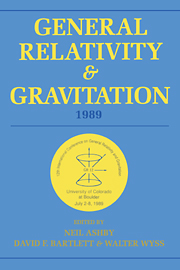 General Relativity and Gravitation, 1989
General Relativity and Gravitation, 1989 Book contents
- Frontmatter
- Contents
- Preface
- Conference committees
- Part A Classical relativity and gravitation theory
- 1 Colliding waves in general relativity
- 2 How fast can pulsars spin?
- 3 Global properties of solutions to Einstein's equations
- 4 Progress in 3D numerical relativity
- WORKSHOPS
- Part B Relativistic astrophysics, early universe, and classical cosmology
- WORKSHOPS
- Part C Experimental gravitation and gravitational wave detection
- WORKSHOPS
- Part D Quantum gravity, superstrings, quantum cosmology
- WORKSHOPS
- Part E Overviews-past, present, and future
1 - Colliding waves in general relativity
Published online by Cambridge University Press: 05 March 2012
- Frontmatter
- Contents
- Preface
- Conference committees
- Part A Classical relativity and gravitation theory
- 1 Colliding waves in general relativity
- 2 How fast can pulsars spin?
- 3 Global properties of solutions to Einstein's equations
- 4 Progress in 3D numerical relativity
- WORKSHOPS
- Part B Relativistic astrophysics, early universe, and classical cosmology
- WORKSHOPS
- Part C Experimental gravitation and gravitational wave detection
- WORKSHOPS
- Part D Quantum gravity, superstrings, quantum cosmology
- WORKSHOPS
- Part E Overviews-past, present, and future
Summary
Introduction
The gravitational interaction between waves is a phenomenon in which the richness and the originality of the theory of general relativity are explicitly manifested. It became apparent in 1970-71 when Khan, Penrose and Szekeres found the first exact solutions describing the collision of pure gravitational waves: it was shown that when two plane gravitational waves with collinear polarization, and with a step or an impulsive profile collide, their subsequent interaction culminates in the creation of a curvature singularity, an event unpredicted by any linearized version of the theory of gravity. As we shall see, this is only a particular result, although probably the most remarkable, of the interaction of gravitational waves. Similar behaviors are also manifested when waves of a different nature collide. This is due to the fact that any kind of energy generates a gravitational field. As a consequence, when two arbitrary waves collide, a gravitational interaction will accompany, as a side effect, the interaction which is peculiar to the particular fields considered. These gravitational effects, though negligible to some extent, are nevertheless relevant from a theoretical point of view. In this lecture we shall investigate the main features of the scattering of plane waves in terms of exact solutions of Einstein's equations. Therefore, let us start by explaining what gravitational plane waves are and how to find exact solutions of Einstein's equations describing their interaction.
- Type
- Chapter
- Information
- General Relativity and Gravitation, 1989Proceedings of the 12th International Conference on General Relativity and Gravitation, pp. 3 - 20Publisher: Cambridge University PressPrint publication year: 1990
- 2
- Cited by
